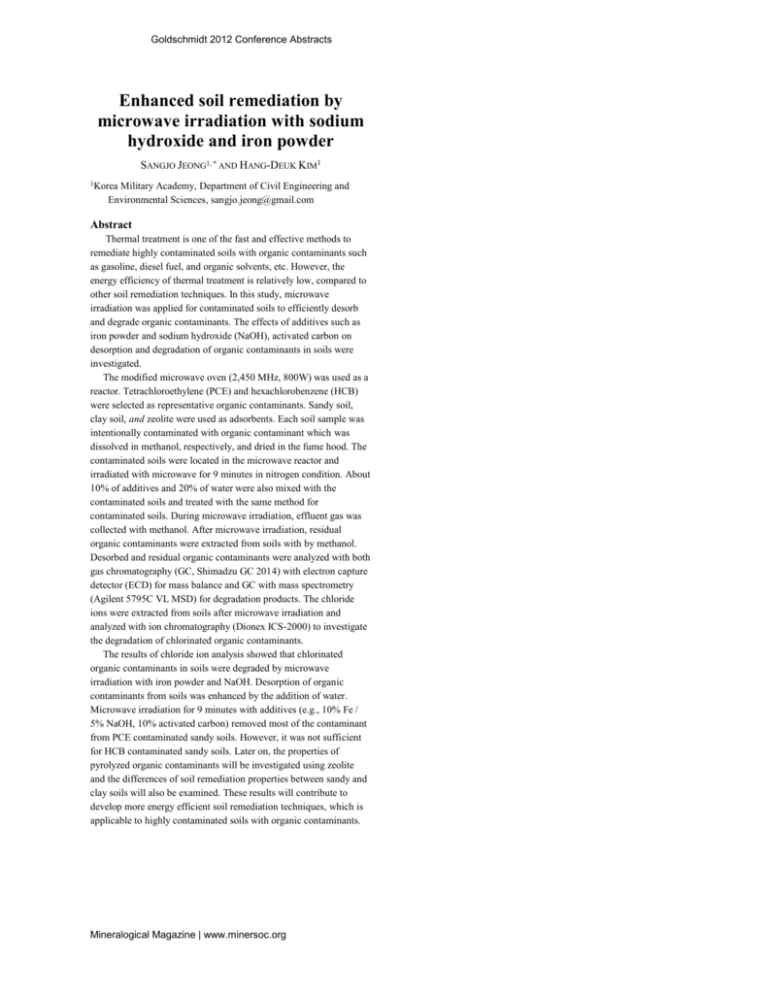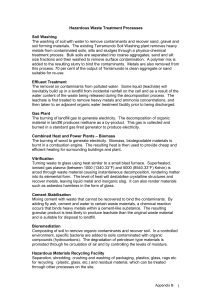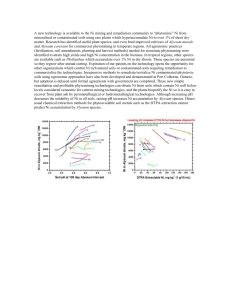Material properties and microstructure from
advertisement

Goldschmidt 2012 Conference Abstracts Enhanced soil remediation by microwave irradiation with sodium hydroxide and iron powder SANGJO JEONG1, * AND HANG-DEUK KIM1 1Korea Military Academy, Department of Civil Engineering and Environmental Sciences, sangjo.jeong@gmail.com Abstract Thermal treatment is one of the fast and effective methods to remediate highly contaminated soils with organic contaminants such as gasoline, diesel fuel, and organic solvents, etc. However, the energy efficiency of thermal treatment is relatively low, compared to other soil remediation techniques. In this study, microwave irradiation was applied for contaminated soils to efficiently desorb and degrade organic contaminants. The effects of additives such as iron powder and sodium hydroxide (NaOH), activated carbon on desorption and degradation of organic contaminants in soils were investigated. The modified microwave oven (2,450 MHz, 800W) was used as a reactor. Tetrachloroethylene (PCE) and hexachlorobenzene (HCB) were selected as representative organic contaminants. Sandy soil, clay soil, and zeolite were used as adsorbents. Each soil sample was intentionally contaminated with organic contaminant which was dissolved in methanol, respectively, and dried in the fume hood. The contaminated soils were located in the microwave reactor and irradiated with microwave for 9 minutes in nitrogen condition. About 10% of additives and 20% of water were also mixed with the contaminated soils and treated with the same method for contaminated soils. During microwave irradiation, effluent gas was collected with methanol. After microwave irradiation, residual organic contaminants were extracted from soils with by methanol. Desorbed and residual organic contaminants were analyzed with both gas chromatography (GC, Shimadzu GC 2014) with electron capture detector (ECD) for mass balance and GC with mass spectrometry (Agilent 5795C VL MSD) for degradation products. The chloride ions were extracted from soils after microwave irradiation and analyzed with ion chromatography (Dionex ICS-2000) to investigate the degradation of chlorinated organic contaminants. The results of chloride ion analysis showed that chlorinated organic contaminants in soils were degraded by microwave irradiation with iron powder and NaOH. Desorption of organic contaminants from soils was enhanced by the addition of water. Microwave irradiation for 9 minutes with additives (e.g., 10% Fe / 5% NaOH, 10% activated carbon) removed most of the contaminant from PCE contaminated sandy soils. However, it was not sufficient for HCB contaminated sandy soils. Later on, the properties of pyrolyzed organic contaminants will be investigated using zeolite and the differences of soil remediation properties between sandy and clay soils will also be examined. These results will contribute to develop more energy efficient soil remediation techniques, which is applicable to highly contaminated soils with organic contaminants. Mineralogical Magazine | www.minersoc.org








